新版人教版七年级英语下册第三单元教案
七年级英语下册第三单元教案(新人教版)

七年级英语下册第三单元教案(新人教版)教学目标1.学习掌握与购物相关的词汇与表达方式。
2.学会询问价格和询问并给予建议。
3.能够运用所学知识进行口语练习和书写练习。
教学重点1.学习购物相关的词汇。
2.学会用英语询问价格和给予建议。
教学难点1.如何运用所学知识进行口语练习。
2.如何在实际情境中进行购物对话。
教学准备1.教材:新人教版七年级英语下册。
2.多媒体设备。
教学过程导入(5分钟)1.利用多媒体展示一些不同商品的图片,通过简单提问引导学生进入课堂主题。
2.引导学生讨论以下问题:What can you buy in a store? How do you ask the price? How do you bargain?学习新知(20分钟)1.呈现与购物有关的词汇,并利用多媒体进行配图,帮助学生理解词汇的意义。
词汇包括:price, discount, cashier, customer, etc.2.向学生介绍并练习询问价格的句型,例如:How much is it? 或者How much does it cost?3.向学生介绍并练习给予建议的句型,例如:I think you should buy… 或者Wh y don’t you try…?4.利用多媒体进行示范,让学生模仿老师的语音、语调和表达方式。
情境对话(15分钟)1.学生分成小组,每组两人,一人扮演顾客,一人扮演售货员。
2.学生根据所给的商品图片进行情境对话,练习询问价格和给予建议。
3.在对话的过程中,教师可以巡视并指导学生,纠正他们的语音和语法错误。
讨论与练习(15分钟)1.教师提出一些与购物相关的问题,例如:What’s your favorite store? How often do you go shopping? Do you prefer shopping online or in stores?2.学生利用所学句型进行回答,并互相组织小组讨论。
人教版七年级英语下册Unit3大单元教学设计
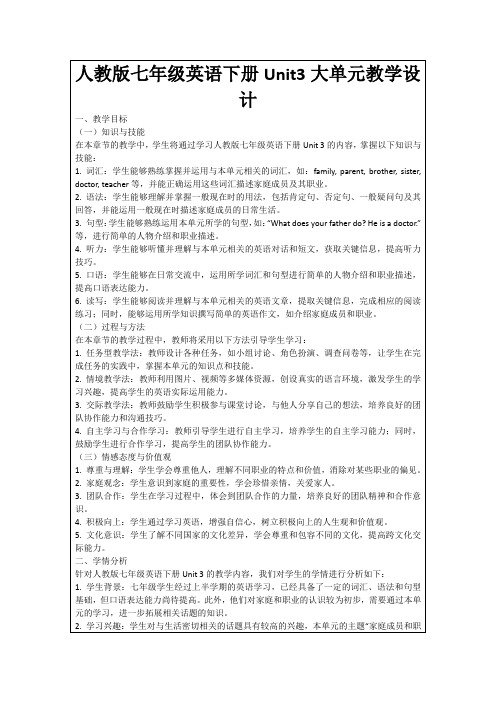
3.阅读理解:阅读与本单元主题相关的文章,完成相应的阅读理解题目,锻炼学生的阅读技巧和信息提取能力。
4.口语作业:准备一段关于自己家庭成员和职业的介绍,下节课进行课堂展示,要求使用本单元所学的句型和词汇,提高学生的口语表达能力。
5.合作意识:七年级学生正处于青春期,个性鲜明,合作意识相对较弱。教师应通过小组活动、角色扮演等形式,培养学生的团队协作能力和沟通技巧。
6.个体差异:学生在英语学习上存在一定的个体差异,教师需关注每个学生的学习状况,因材施教,使每个学生都能在原有基础上得到提高。
三、教学重难点和教学设想
(一)教学重难点
2.分步教学,逐步突破语法难点:
-通过对比一般现在时的肯定句、否定句和一般疑问句的结构,让学生观察、总结语法规则。
-利用图表、例句、练习等多种形式,帮助学生掌握一般现在时的用法,并通过小组合作、角色扮演等活动进行巩固。
3.互动交流,提升口语能力:
-采用问答、讨论等形式,鼓励学生用英语进行交流,提高口语表达能力。
1.重点:本单元的重点在于掌握一般现在时的用法,包括肯定句、否定句、一般疑问句及其回答,以及熟练运用与家庭成员和职业相关的词汇、句型进行交流。
2.难点:
-一般现在时的肯定句、否定句转换,以及一般疑问句的构成和回答。
-不同职业词汇的正确拼写和发音。
-口语表达中,正确使用本单元所学的句型和词汇描述家庭成员及其职业。
2.教师提出问题:“What does your father/mother do?”,让学生用英语回答,活跃课堂氛围,为新课的学习做好铺垫。
3.引入本节课的主题:“Let's talk about our family members and their jobs.”,让学生明确学习目标。
初一七年级英语下册人教版Unit 3 How do you get to school? 单元教案、教学设计
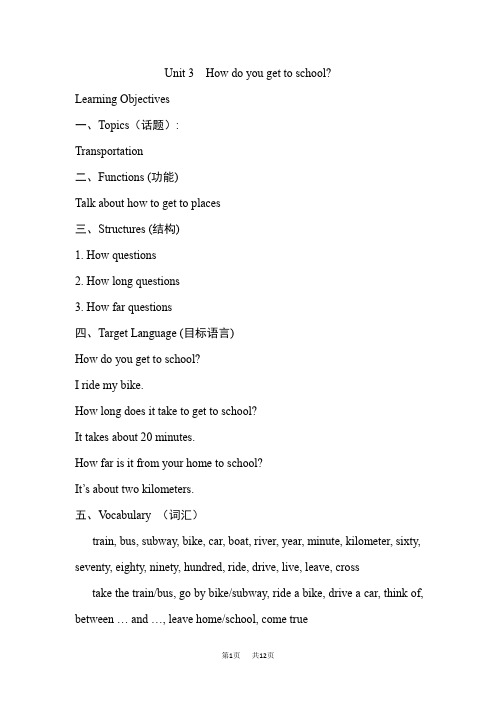
Unit 3 How do you get to school?Learning Objectives一、Topics(话题):Transportation二、Functions (功能)Talk about how to get to places三、Structures (结构)1. How questions2. How long questions3. How far questions四、Target Language (目标语言)How do you get to school?I ride my bike.How long does it take to get to school?It takes about 20 minutes.How far is it from your home to school?It’s about two kilometers.五、V ocabulary (词汇)train, bus, subway, bike, car, boat, river, year, minute, kilometer, sixty, seventy, eighty, ninety, hundred, ride, drive, live, leave, cross take the train/bus, go by bike/subway, ride a bike, drive a car, think of, between … and …, leave home/school, come true六、Skills (技能)Listening for key informationScanning in reading七、Recycling (复习巩固)Numbers 1–30I usually …It is easy to …Thanks for …八、教材分析本单元以How do you get to school?为中心话题,主要运用How long/How far 询问“去某地的交通方式、时间、距离”,简单描述路线。
人教版七年级英语下册Unit3SectionB(2a2c)教学设计

3.利用图片和关键词,引导学生复习已学过的相关词汇,如:robots、traffic、pollution、clean等,为新课的学习做好铺垫。
(二)讲授新知
1.教师呈现一般将来时态的句子,如:“I will have a robot in the future.”,引导学生观察并总结一般将来时态的构成和用法。
2.通过对比一般现在时、一般过去时,让学生感知一般将来时态的特点,重点讲解“主将从现”的语法结构。
3.结合课本2a部分的内容,让学生听录音并跟读,加强对一般将来时态的语音、语调感知。
人教版七年级英语下册Unit3SectionB(2a2c)教学设计
一、教学目标
(一)知识与技能
在本章节的学习中,学生将掌握以下知识与技能:
1.能够熟练运用本节课所学的词汇,如:future、robots、traffic、pollution、clean等,并能在实际语境中进行运用。
2.能够掌握一般将来时态的用法,并能在句子中正确运用。
(1)一般将来时态在句子中的正确运用,特别是主将从现的语法结构。
(2)听力训练中,学生对较长、较复杂句子的理解。
(3)学生在口语表达中,如何将所学知识灵活运用到实际语境中。
(二)教学设想
1.创设情境,激发兴趣:通过展示未来科技发展的图片和视频,激发学生对未来生活的兴趣,为新课的学习营造氛围。
2.分步骤教学,循序渐进:
2.学生分享自己在课堂中的收获和感悟,教师给予肯定和鼓励。
新版人教版七下英语第3单元教案
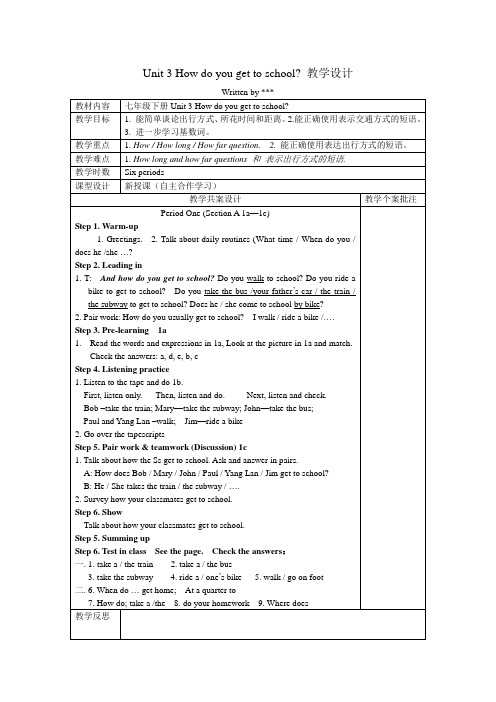
Step3.3a
Pre-learning. Read the questions and the answers. Do it alone.
Check the answers with your partner. Discuss your problems. c, e, d, a, b
1. Talk about how the Ss get to school. Ask and answer in pairs.
A: How does Bob / Mary / John / Paul / Yang Lan / Jim get to school?
B: He / She takes the train / the subway /….
二.11. How does 12. How long 13. How far14. How long does it take from your home to your grandparents’ (home) by bike?
教学反思
Unit3How do you get to school?教学设计
2. Pair work: How do you usually get to school?Iwalk / ride a bike /….
Step3. Pre-learning1a 1a,Look atthe picture in 1a and match.
Unit3How do you get to school?教学设计
Written by***
教材内容
七年级下册Unit3How do you get to school?
教学目标
有课后反思的七年级人教版英语下册第三单元教案
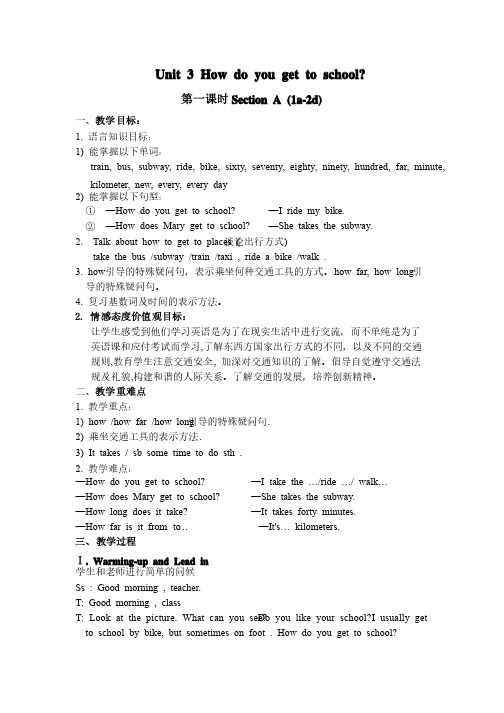
Unit 3 How do you get to school?第一课时Section A (1a-2d)一、教学目标:1. 语言知识目标:语言知识目标:1) 能掌握以下单词:能掌握以下单词:train, bus, subway, ride, bike, sixty, seventy, eighty, ninety, hundred, far, minute, kilometer, new, every, every day 2) 能掌握以下句型:能掌握以下句型:① —How do you get to school? —I ride my bike. ② —How does Mary get to school? —She takes the subway. 2. Talk about how to get to places (谈论出行方式) take the bus /subway /train /taxi , ride a bike /walk . 3. how 引导的特殊疑问句,表示乘坐何种交通工具的方式。
how far, how long 引导的特殊疑问句。
导的特殊疑问句。
4. 复习基数词及时间的表示方法。
复习基数词及时间的表示方法。
2. 情感态度价值观目标:让学生感受到他们学习英语是为了在现实生活中进行交流,而不单纯是为了英语课和应付考试而学习,了解东西方国家出行方式的不同,了解东西方国家出行方式的不同,以及不同的交通以及不同的交通规则,教育学生注意交通安全, 加深对交通知识的了解。
倡导自觉遵守交通法规及礼貌,构建和谐的人际关系。
了解交通的发展,培养创新精神。
二、教学重难点1. 教学重点:教学重点:1) how /how far /how long 引导的特殊疑问句. 2) 乘坐交通工具的表示方法. 3) It takes / sb some time to do sth . 2. 教学难点:教学难点:—How do you get to school? —I take the …/ride …/ walk… —How does Mary get to school? —She takes the subway. —How long does it take? —It takes forty minutes. —How far is it from … to … —It's It's…… kilometers. 三、教学过程Ⅰ. Warming-up and Lead in 学生和老师进行简单的问候学生和老师进行简单的问候Ss : Good morning , teacher. T: Good morning , class T: Look at the picture. What can you see? Do you like your school? I usually get to school by bike, but sometimes on foot . How do you get to school? Ss 按实际情况作答按实际情况作答S1: I ride my bike. S2: I go by bus. S3: ………T: V ery good. You’re clever. Let’s learn Unit 4 Section A. 之后板书:之后板书:“Unit 4 How do you get to school?”Ⅱ. Presentation 1. T: If you are here, but your school is in Shanghai. How do you get to school? Ss: I take the bus /plane/ boat / ship / car / taxi I ride a bike / motorbike T: Do you know any other way? 2. Teacher shows pictures on the big screen .归纳出行方式和常用短语. Ask some questions about how you get to…? (让学生积极主动的思考想象总结,多媒体增加趣味性,加强直观性,效果事半功倍) 3. Show a picture about Part 1, on the screen. Point at girls or boys in the picture. Ask students to answer and write in the blanks. S1 : How does he / she go to school? S2 : He / She … …Ⅲ. 1a T: Look at the picture on your book. Match the words with the picture. (学生们完成1a 的学习任务,然后校对答案) Ⅳ. Listening 1. Make sure the Ss know what to do. Give them an example orally if possible. 2. Read the names in the box. 3. Play the tape and check the answers. Ⅴ. Pair work Ask two students to read the dialogue in the speech bubbles to the class. Then ask students students to to to work work work in in in pairs. pairs. pairs. Ask Ask Ask and and and answer answer answer how how how students students students get get get to to to school school school in in in the the picture. Finally ask some pairs of students to present their conversations to the class. Ⅵ. Listening 1. 1. Revise Revise Revise the the the numbers, numbers, numbers, first, first, first, zero~nine, zero~nine, zero~nine, next, next, next, ten~nineteen, ten~nineteen, ten~nineteen, then, then, then, twenty, twenty, thirty, forty forty……finally, twenty-one, twenty-two… Teach the new word "hundred". 2. Play the tape for the students to finish 2a. Then play again and check the answers Ⅶ. Presentation Section A (1a-2d) 1. —How do you get to school? —I ride my bike? —How does Mary get to school? —She takes the subway. 2. 表达“几十” 个位数字+ty twenty, thirty, 一定要用连字符 twenty-five, sixty-nine 表达“几十几” 一定要用连字符hundred one hundred, two hundred 3. ① How does Jane get to school? ② How far is it from home to school? ③ How long does it take to get to school from her home? 课后反思:引入环节可以先让学生以小组活动为主要练习方式,引入环节可以先让学生以小组活动为主要练习方式,让学生讨论他们让学生讨论他们所知道的交通工具,所知道的交通工具,并把它们画出来,并把它们画出来,并把它们画出来,由小组长汇总,由小组长汇总,由小组长汇总,并填表向全班同学展示讨并填表向全班同学展示讨论结果,论结果,全班评选出哪一组知道的交通工具多,全班评选出哪一组知道的交通工具多,全班评选出哪一组知道的交通工具多,并看谁画得棒。
七年级英语下册第三单元教案(新人教版).doc

七年级英语下册第三单元教案(新人教版)unit 3 how do you get to school?一、重点词汇1. one hundred and five表示具体的“几百”时,用“基数词+hundred”表示,注意此时hundred不能加s.hundreds of表示“数百;成百上千的”,这是hundred后面有s,而且hundreds后面要有介词of,并且不能与数词连用。
与hundred 用法类似的还有单词:thousand,million,billion.our school is so famousthat_____ people come and visit it every term.a. hundred b. hundreds c. hundred of d. hundreds of 2. i ride it to school every day.ride “骑”,后可接bike, horse, motorbike等。
还可以用做可数名词,“旅程”。
an hour’s ride 乘车一个小时的路程every “每个;每一”,其后接单数可数名词。
every day “每天”every day 表示某事发生的频率,“每天,天天”。
i go to school every day.everyday 形容词,“日常的,普通的”。
i study everyday english every day.3. livelive 不及物动词,“居住,生活”,其后若跟名词则必须在名词前加上适当的介词。
i like to live in the country.live on sth. “以某物为食”sheep live on grass.live a ...life “过、、、生活”t he old man lives a happy life.4. bus stopbusstop与bus station 都是指“公342019--10unit 3 how do you get to school?一、重点词汇1. one hundred and five表示具体的“几百”时,用“基数词+hundred”表示,注意此时hundred不能加s.hundreds of表示“数百;成百上千的”,这是hundred后面有s,而且hundreds后面要有介词of,并且不能与数词连用。
人教版新目标七年级英语下册 Unit 3 教学设计
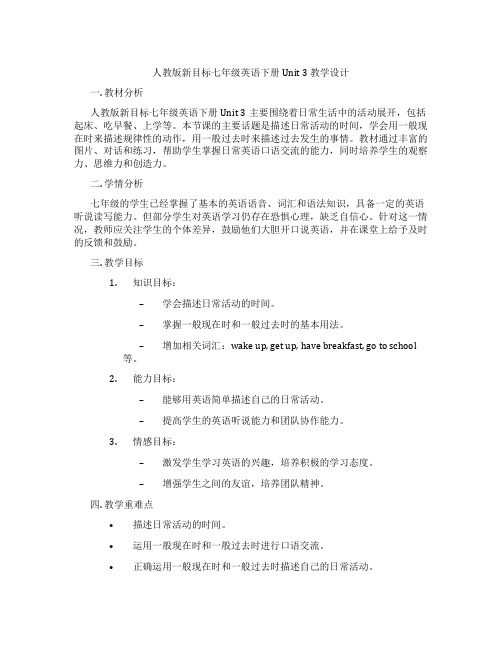
人教版新目标七年级英语下册 Unit 3 教学设计一. 教材分析人教版新目标七年级英语下册Unit 3主要围绕着日常生活中的活动展开,包括起床、吃早餐、上学等。
本节课的主要话题是描述日常活动的时间,学会用一般现在时来描述规律性的动作,用一般过去时来描述过去发生的事情。
教材通过丰富的图片、对话和练习,帮助学生掌握日常英语口语交流的能力,同时培养学生的观察力、思维力和创造力。
二. 学情分析七年级的学生已经掌握了基本的英语语音、词汇和语法知识,具备一定的英语听说读写能力。
但部分学生对英语学习仍存在恐惧心理,缺乏自信心。
针对这一情况,教师应关注学生的个体差异,鼓励他们大胆开口说英语,并在课堂上给予及时的反馈和鼓励。
三. 教学目标1.知识目标:–学会描述日常活动的时间。
–掌握一般现在时和一般过去时的基本用法。
–增加相关词汇:wake up, get up, have breakfast, go to school 等。
2.能力目标:–能够用英语简单描述自己的日常活动。
–提高学生的英语听说能力和团队协作能力。
3.情感目标:–激发学生学习英语的兴趣,培养积极的学习态度。
–增强学生之间的友谊,培养团队精神。
四. 教学重难点•描述日常活动的时间。
•运用一般现在时和一般过去时进行口语交流。
•正确运用一般现在时和一般过去时描述自己的日常活动。
•学会在适当的情境下使用一般现在时和一般过去时。
五. 教学方法1.情境教学法:通过设定生活情境,让学生在实际语境中学习、运用英语。
2.任务型教学法:引导学生参与各种小组活动,提高学生的团队协作能力和口语表达能力。
3.激励评价法:及时给予学生反馈,关注学生的点滴进步,激发学生的学习兴趣。
六. 教学准备1.教学素材:教材、多媒体课件、录音机、磁带、相关图片等。
2.教学工具:黑板、粉笔、投影仪等。
七. 教学过程1.导入(5分钟)–教师与学生用英语进行自由谈话,引导学生谈论日常活动。
–提问:What time do you get up? What do you have for breakfast? 让学生用英语回答。
- 1、下载文档前请自行甄别文档内容的完整性,平台不提供额外的编辑、内容补充、找答案等附加服务。
- 2、"仅部分预览"的文档,不可在线预览部分如存在完整性等问题,可反馈申请退款(可完整预览的文档不适用该条件!)。
- 3、如文档侵犯您的权益,请联系客服反馈,我们会尽快为您处理(人工客服工作时间:9:00-18:30)。
Unit 3. How do you get to school?一、考点、热点回顾【语法】1.交通方式表达法(1)用“by + 交通工具名词”表示交通方式。
此时交通工具的名词只能用单数,不能用复数,也不能被冠词或物主代词等限定。
如:by bike, by bus, by train, by ship, by planeThey often go home by bus.(2)用“by + 交通路线的位置”表示交通方式。
如: by land, by water, by sea, by airThey go to England by air.(3)用“in/on+ 交通工具名词”。
此时交通工具名词前必须有冠词、名词所有格形式或形容词性物主代词等限定词修饰。
其用法与“by+ 交通工具名词”He often goes to school on a (his) bike.(4)用“take a/the+ 交通工具名词”表示交通方式。
如:take a bus, take a train, take a ship, take a plane, ride a bikeWill you take a bus to go there?(5)表示“步行去某地”,a)go to +某地+on foot 如:She goes to work on foot.b)walk to +某地(walk to 后接地点副词here, there, home时,介词to 要省去)如:He walks to school every day.I usually walk home.【练习】(1). ——_____ do you get to the zoo?——Take the bus.A. WhatB. HowC. WhichD. When(2). 你通常怎么到学校?______do you usually _____ to school?(3).——______ _____ is it ______ your home ______ the hospital? 从你家到医院有多远?——It’s about three kilometers. 大约有3千米远。
(4) Allan will go back to England by plane next month. (就画线部分提问)_____ _____ Allan go back to England next month?2.不一样的“到达”:get to, reach, arrive in/atget 是不及物动词,当后面接表示地点的名词时应和介词to连用,但如果是接here, there 等地点副词时,应省略to.reach是及物动词,后面可以直接跟名词arrive是不及物动词,后面接大地点时,用arrive in, 接小地点时,用arrrive at. 但当接here, there 等地点副词时,不用介词。
【练习】(1) With the help of the Internet, news can _____ every corner of the word.A. arriveB. reachC. goD. get(2) They arrived ______ London on the morning of July 2nd.A. atB. inC. onD. to(3) They _____ the station at 7:00 yesterday morning.A. getB. get toC. got toD. got3.学会hundred的用法hundred是数词,意为“一百”,当我们表示几百时,用基数词+hundred。
注意此时hundred不加s, 也不带of.例:There are eight hundred students in our school.当表示笼统的概念数百时,常在词尾加-s,而且和of连用。
前面不能有数词例:There are hundreds of people in the restaurant.【扩展】类似用法的数词还有thousand千, million百万,billoin十亿【练习】(1)有数百人参加运动会___________ ____________people take part in the sports meet.(2) Tom spent two ________ and fifteen dollars on that yellow coat.A. hundredsB. hundredC. hundreds ofD. hundred of例:It took us 10 minutes to go to the station.Mr. Brown spent most of his money on books. / in buying booksThe coat cost me 100 yuanHe paid her 10 yuan for this book.【练习】:用take, spend, cost, pay的适当形式填空(1) 写那本书花了他两年半的时间。
It _____ him two years and a half to write the book.(2) 你们得在口语上花更多时间。
You have to _____ much more time on spoken English.(3) 那些书花了我200元钱。
Those books ______ me two hundred yuan.(4) 你付你的厨师多少报酬?How much did you ______ your cook?(5) How much does the ticket _____ from Shanghai to Beijing?A. costB. takeC. spendD. pay(6) It_____ me half an hour ______ my homework every day.A. takes; doB. takes; to doC. spends; doD. spend; doing5. 揭开stop 的面纱stop做名词时,意为:车站做动词时,意为:停止,阻止常见句型结构:stop doing sth.停止做某事Stop to do sth. 停止,中断做某事然后去做另一件事。
【练习】(1) Let’s stop _____. I know a good restaurant near here.A. to have a mealB. to have a restC. having a restD. having a meal(2) Please stop _____ and listen to the teacher.A. readB. to readC. readsD. reading(3) Today the forests have almost gone. We must stop people from _____ too many trees.A. cutB. to cutC. cuttingD. cutting6. 部分否定not allnot all这个结构表示的是“部分否定”,意为:并不是所有的...都.当not 用于代词all, many, much,every, both 前时,均属于部分否定。
例:Not all students are good at maths. 并非所有学生都擅长数学。
【延伸】:当表示全部否定时,用none.例:None of the answers are/is right. 没有一个答案是对的。
【练习】(1) 他们中没有一个是中国人。
_____ ______ ______ are Chinese.(2) 并非一切都好。
______ ______ is OK.(3) Xiao Li is the right person to show the foreigners around, for_____ of us can speak English.A. allB. eachC. bothD. none7. 重点句型:What do you think of ….?What do you think of ….是用来询问某人对某事或某人的看法的交际用语。
也可以说how do you like...?例:What do you think of Joan? 你觉得琼怎么样?【练习】(1) ——What do you think of the baseball match?——______.A.Our team lost the matchB. I didn’t hear of itB. C. It was very exciting D. Our team was a good one(2) ——What do you think of this film?——______.A. It’s wonderfulB. Not at allC. Got ideaD. With pleasure(3) ——_______ do you like the film? ——Very interesting.A. HowB. WhoC. WhatD. When8. 生活中有太多的“if”If 引导的条件状语从句,如果主句是一般将来时,祈使句或含有情态动词,条件状语从句一般用一般现在时。
例:We’re leaving for shanghai if it doesn’t rain tomorrow.I can see the doctor quickly if i get there earlyPlay basketball with me if you finish your homework.注意:从句一般放在主句的后面,若放句首要加逗号隔开。
【练习】(1) ——Mary, what about going boating if it _____ tomorrow?——Good idea!A. not rainB. rainC. rainsD. doesn’t rain(2) You can ask the teacher for help ______ you don’t know the answer.A. whereB. whoC. ifD. What用括号内所给单词(词组)的适当形式填空。
